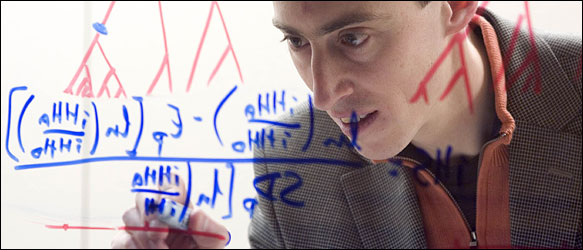Like many top executives, James R. Lavoie and Joseph M. Marino keep a close eye on the stock market. But the two men, co-founders of Rite-Solutions, a software company that builds advanced — and highly classified — command-and-control systems for the Navy, don't worry much about Nasdaq or the New York Stock Exchange.
Instead, they focus on an internal market where any employee can propose that the company acquire a new technology, enter a new business or make an efficiency improvement. These proposals become stocks, complete with ticker symbols, discussion lists and e-mail alerts. Employees buy or sell the stocks, and prices change to reflect the sentiments of the company's engineers, computer scientists and project managers — as well as its marketers, accountants and even the receptionist.
"We're the founders, but we're far from the smartest people here," Mr. Lavoie, the chief executive, said during an interview at Rite-Solutions' headquarters outside Newport, R.I. "At most companies, especially technology companies, the most brilliant insights tend to come from people other than senior management. So we created a marketplace to harvest collective genius." That's a refreshing dose of humility from a successful C.E.O. with decades of experience in his field. (Mr. Lavoie, 59, is a Vietnam War veteran and an accomplished engineer who has devoted his career to military-oriented technologies.)
Most companies operate under the assumption that big ideas come from a few big brains: the inspired founder, the eccentric inventor, the visionary boss. But there's a fine line between individual genius and know-it-all arrogance. What happens when rivals become so numerous, when technologies move so quickly, that no corporate honcho can think of everything? Then it's time to invent a less top-down approach to innovation, to make it everybody's business to come up with great ideas.
That's a key lesson behind the rise of open source technology, most notably Linux. A ragtag army of programmers organized into groups, wrote computer code, made the code available for anyone to revise and, by competing and cooperating in a global community, reshaped the market for software. The brilliance of Linux as a model of innovation is that it is powered by the grass-roots brilliance of the thousands of programmers who created it. According to Tim O'Reilly, the founder and chief executive of O'Reilly Media, the computer book publisher, and an evangelist for open source technologies, creativity is no longer about which companies have the most visionary executives, but who has the most compelling "architecture of participation." That is, which companies make it easy, interesting and rewarding for a wide range of contributors to offer ideas, solve problems and improve products?
At Rite-Solutions, the architecture of participation is both businesslike and playful. Fifty-five stocks are listed on the company's internal market, which is called Mutual Fun. Each stock comes with a detailed description — called an expect-us, as opposed to a prospectus — and begins trading at a price of $10. Every employee gets $10,000 in "opinion money" to allocate among the offerings, and employees signal their enthusiasm by investing in a stock and, better yet, volunteering to work on the project. Volunteers share in the proceeds, in the form of real money, if the stock becomes a product or delivers savings.
Mr. Marino, 57, president of Rite-Solutions, says the market, which began in January 2005, has already paid big dividends. One of the earliest stocks (ticker symbol: VIEW) was a proposal to apply three-dimensional visualization technology, akin to video games, to help sailors and domestic-security personnel practice making decisions in emergency situations. Initially, Mr. Marino was unenthusiastic about the idea — "I'm not a joystick jockey" — but support among employees was overwhelming. Today, that product line, called Rite-View, accounts for 30 percent of total sales.
"Would this have happened if it were just up to the guys at the top?" Mr. Marino asked. "Absolutely not. But we could not ignore the fact that so many people were rallying around the idea. This system removes the terrible burden of us always having to be right."
Read the whole story here...
|
 ;
;









